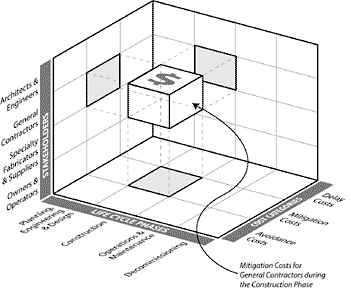Unveiling The New MasterFormat 2004 Edition
Poor information coordination costs $billions
But the value of MasterFormat 2004 Edition reaches far beyond efficiency, convenience, and improved communication. It is a potent tool that reaches where it counts: the bottom line. By providing the means for documenting and costing each life cycle stage, from planning to renovation to demolition to salvage, it offers all parties involved in the construction process-especially facility owners, a control over finances that does not presently appear to exist.
A recent federally funded study sponsored by the National Institute of Standards and Technology reports that poor data coordination costs building owners and others in the capital facilities industry a very conservative $15.8 billion a year. Titled Cost Analysis of Inadequate Interoperability in the U.S. Capital Facilities Industry (NIST GCS 04-867, http://fire.nist.gov/bfrlpubs/build04/PD./b04022.pdf), the study focuses on commercial and institutional buildings and industrial facilities. It traces facility information flow from planning and programming, through design and construction, to operation and maintenance, at each stage figuring the cost of poor communication born by different stakeholders.
|
Defining interoperability as ‘relating to both the exchange and management of electronic information, where individuals and systems would be able to identify and access information seamlessly, as well as comprehend and integrate information across multiple systems,' the study reveals examples of inefficiencies. In addition to manual reentry of data, they include duplication of business functions, and the continued reliance on paper-based information management systems. Problems stem, the study reports, from the highly fragmented nature of the industry and are further compounded by the large number of small companies that have not adopted advanced information technologies. On the brighter side, the report notes, even small improvements in efficiency potentially represent significant economic benefits.
Equally significant as the considerable sum of dollars lost is who bears the burden. Of the three general cost categories used in the study-avoidance costs before problems occur, mitigation costs incurred after problems occur, and costs of delays-owners, according to the study, pay the most, about two thirds or $10.6 billion a year, in redundant data costs, predominantly during ongoing facility operation and maintenance. General contractors and specialty fabricators and suppliers bear $1.8 billion and $2.2 billion respectively, while architects and engineers have the lowest interoperability costs at $1.2 billion-a figure comparable to the $1.3 billion costs born by general contractors during the construction phase (see figure ES-1 for a graphical depiction of mitigation losses by general contractors). Not surprisingly, the largest losses ($1.0 billion) sustained by architects and engineers occur during the planning, design, and engineering phase; their subsequent avoidance and mitigation costs amount to $485 million and $684 million, respectively.










